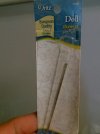- Joined
- Jan 19, 2009
- Messages
- 312
Here's a question for Paul, Omega Leather, Horsewright, and others that are solid leather makers - I have a bit of a stitching quandary guys. I'm sure the answer is simple and I'll feel stupid when I hear the answer but I would really like to improve this aspect of my leather work. I'll start by telling you how I do things:
Say I'm making a simple fixed blade sheath with three layers (front, back and welt). I cut my pieces of leather using my pattern and glue them together. When the glue is dry, I take them to the belt sander to round edges, get all the pieces edges flush with each other, etc. I come back with my track tool and cut the track where the stitching will go. I then take my stitch roller (usually a 5 or 7 stitches per inch since I'm doing small stuff) and mark where the stitches go.
Here is where I need advice: I do not have a sewing machine and do all my stitching by hand; two needles, saddle stitch. To actually punch the holes, I am using an awl needle in a drill press (without the drill press spinning) and punch a hole at a time where I marked my stitches with the roller. I go slow and push the needle straight down through the leather with no side to side or front to back pressure. The problem I have, as you will see in my photos, is the front or top side always looks great when I finish stitching. Turn it over and the stitches can be (more often than not) all over the place. Sometimes they look nearly as nice as the front, but most of the time not.
What I think is happening is my needle is bending as it's being pushed through the leather and doesn't make a hole straight through. Hence the backside stitching is not all nice, straight and even like the front. Should I start using an awl to punch my holes? A different thicker needle in the drill press? Other suggestions? I tried drilling holes with a small drill bit and that turned out even worse than what I've been doing. Thanks in advance!
- Chad
Front side:

Back Side:

Say I'm making a simple fixed blade sheath with three layers (front, back and welt). I cut my pieces of leather using my pattern and glue them together. When the glue is dry, I take them to the belt sander to round edges, get all the pieces edges flush with each other, etc. I come back with my track tool and cut the track where the stitching will go. I then take my stitch roller (usually a 5 or 7 stitches per inch since I'm doing small stuff) and mark where the stitches go.
Here is where I need advice: I do not have a sewing machine and do all my stitching by hand; two needles, saddle stitch. To actually punch the holes, I am using an awl needle in a drill press (without the drill press spinning) and punch a hole at a time where I marked my stitches with the roller. I go slow and push the needle straight down through the leather with no side to side or front to back pressure. The problem I have, as you will see in my photos, is the front or top side always looks great when I finish stitching. Turn it over and the stitches can be (more often than not) all over the place. Sometimes they look nearly as nice as the front, but most of the time not.
What I think is happening is my needle is bending as it's being pushed through the leather and doesn't make a hole straight through. Hence the backside stitching is not all nice, straight and even like the front. Should I start using an awl to punch my holes? A different thicker needle in the drill press? Other suggestions? I tried drilling holes with a small drill bit and that turned out even worse than what I've been doing. Thanks in advance!
- Chad
Front side:

Back Side:





